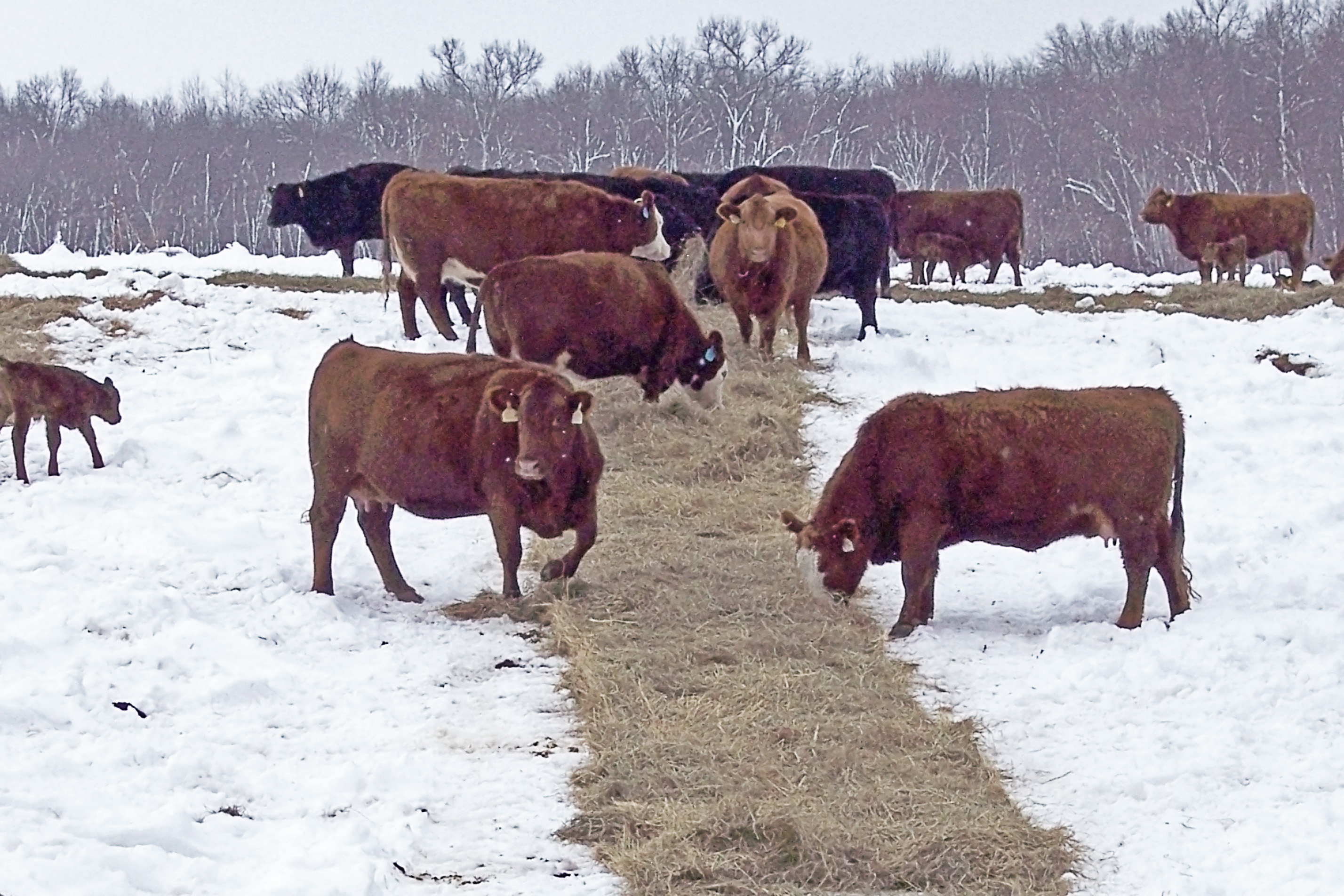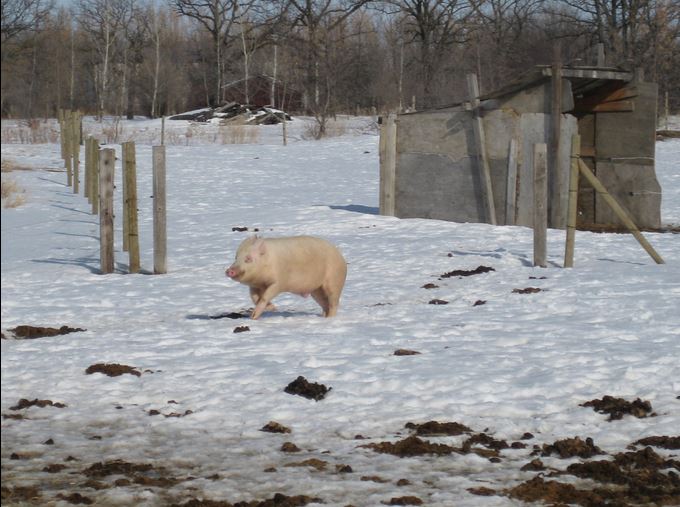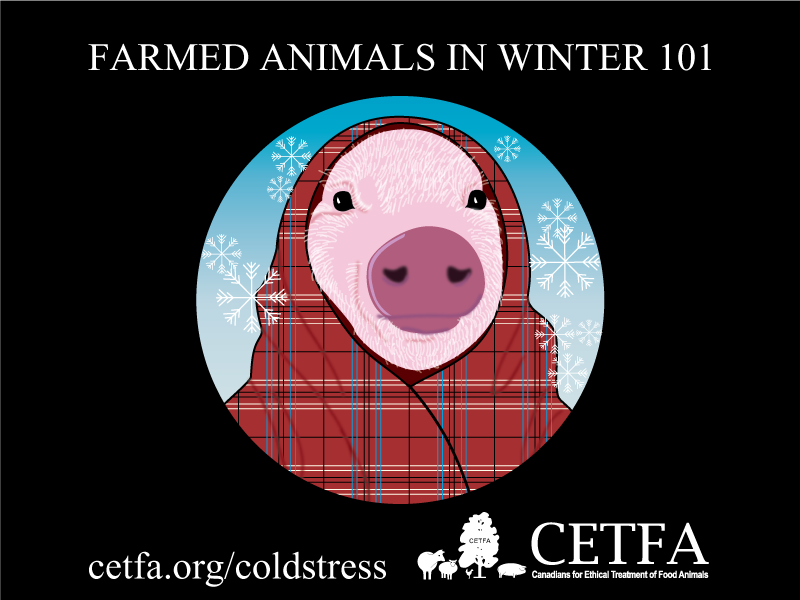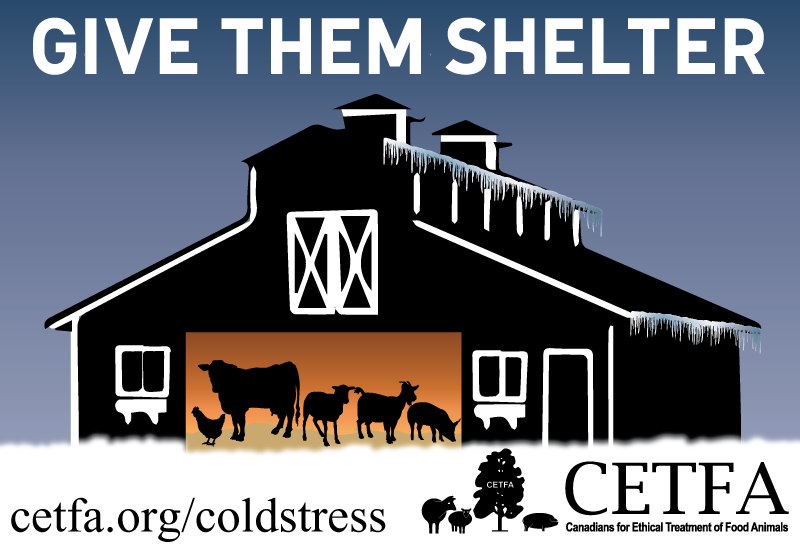Winter is no reason to justify confining farmed animals into sheds for months on hand. In fact, many farmed animals, if given the opportunity, will choose to spend some time outdoors during winter. Even domestic chickens, whose ancestors decent from jungle fowl, may enjoy the outdoors on mild winter days.
However, when extreme cold, wind and/or cold and wet conditions hit, the well-being of the animals may be severely compromised unless adequate measures are taken. These measures can be categorized around 3 basic needs: food, water and shelter.
FOOD
As temperatures drop, farmed animals need to increase the quantity of food they ingest to maintain their body temperature and condition – a requirement that increases even more if the animals are subjected to wet or windy conditions. Without appropriate quantities of food, they may use up all the energy they get from food to generate body heat, thus not having enough energy to maintain their body condition, they may suffer from hypothermia, and in severe cases, die. Providing enough food in the winter is therefore critical, and additional food should be provided to farmed animals when the temperatures drop.
Close attention should be paid to the particular nutritional needs of young, elderly or pregnant animals, who can suffer from cold stress/hypothermia more quickly. Supplements (vitamins, minerals, etc.) should be provided when needed to help maintain optimal health.
Ensuring proper nutrition for the animals all year long, and gradually increasing the quantities of food available as temperatures drop, are also practices essential to help animals cope with cold stress.

Unlike the commonly held belief, the best food to help ruminants (cattle, sheep, goats, etc.) effectively maintain body temperature is actually good qualify hay (or alfalfa), not corn. Minerals should also be provided, using for instance salt blocks for cows, and salt crumbles for sheep and goats. Photo: cafnrnews.com/
WATER
Water is a vital requirement all year long, but is of particular importance in the winter. In cattle, for example, it is indispensable to facilitate the digestion of heat-generating food. Without proper hydration, cows feed less and become more prone to hypothermia. They may also become constipated, or suffer from indigestion and/or colic.
It is often thought that large farmed animals are able to use snow as a source of water in the winter. While this is true to some extent, snow should never be the only source of water available. The potential of snow as a proper source of water depends on various factors, which may not be easily properly gauged and require regular close observation to determine the snow quantity and quality available. In addition, some farmed animals require large quantities of water per day. Left with snow alone as a source of water, these animals may spend too much of their time ingesting snow instead of feeding, all the while the snow lowers their temperature and increases their need for food, thus risking hypothermia. Therefore, snow should never be the only source of water available, and fresh, clean water should be provided in heated containers at all times, regardless of cost, to ensure it is kept free of ice.
Be very careful however, about the existence of stray voltage around the water trough. Stray voltage is a frequent problem on North American farms, and if no precautions are taken, animals may receive electrical shocks. These are not only painful, they may discourage animals from drinking, which could lead to dehydration and eventually death. Click here to learn more about stray voltage and corrective measures.
Pregnant, sick or young animals, as well as lactating animals, may have greater needs for water, and should be particularly closely monitored to ensure they do not get dehydrated.
SHELTER
It is often thought that some farmed animals, such as cattle or sheep, only need hedgerows, natural windbreaks or land features for winter protection. Although these species can handle cold better than others, they can also be at risk of cold stress or hypothermia during winter if they do not have proper protection from the weather. For instance, while the wool on the back of sheep may seem like good insulation from the cold, loads of wet snow on the back of sheep can part their wool, and the animals can get chilled and sick as a result. Cows also lose the insulation provided by their coat when their hairs become wet. Therefore, all farmed animals should have access to a shelter offering them protection from freezing temperatures, wind, snow, sleet, ice and rain, at all times.
Shelters requirements vary for each species, but all shelters must be big enough to allow all animals to be sheltered at once. There should be enough room to move without stepping on each other and stand/lie down in natural positions, and should include bedding to help insulate animals from the cold grounds drawing heat away from the animals’ bodies. Extra-bedding in the form of a deep bed of straw is generally a must. In really cold weather, sheep, for instance, are not able to keep their lower limbs warm without a deep enough bed of straw.

In the winter, lactating cows are at great risk of painful frostbites of the teats. Photo: milkquality.wisc.edu
Bedding should be kept clean and dry, to prevent irritation of the respiratory system through ammonia fumes, or the occurrence of bacterial and virus infections. Shelters must be properly ventilated, but insulated enough to prevent drafts. Finally, snow should not be left to accumulate on shelter’s roofs as a too heavy layer of snow can cause barn roofs to collapse, as recently happened on several Alberta farms.
The areas surrounding the shelter should be kept mud free at all costs to avoid the development of hoof diseases (such as foot rot in cattle and sheep) or injuries due to slippery frozen surfaces, and to prevent mud from coating the animals’ hair (muddy hairs lose their insulating properties).
Paths between shelters, water troughs and feeding stations should also be made in the snow for chickens, to prevent them from getting frostbites when enjoying mild winter snowy days, or to help various animals walk on frozen grounds or hard-packed snow and prevent broken limbs. Various materials can be used, from gravel to sand, woodchips or sawdust, depending on the conditions and the species.
WHAT YOU CAN DO:
As an animal care taker:
– Follow the recommendations above as minimum conditions necessary to ensure your animals fare well during winter. Read books or search the internet for additional information specific to each species.
– Daily monitor all your animals closely, and take immediate action if you suspect one of them is suffering from cold stress. This may mean bringing the animal(s) inside, helping him/her get food and water, wrapping the animal in a blanket to warm him/her up (make sure that the blanket does not become wet or this will lead to hypothermia), and/or calling your veterinarian for help.
If you witness farmed animals suffering from cold stress:
– Call your local SPCA, humane society and/or provincial department of agriculture.
Provide the date of your observations, time, temperature, location and details about the animals in distress.
– If all else fails, contact your local RCMP detachment.
While few to no laws exist to protect farmed animals during their lives on farms, and the general attitude CETFA field investigators have experienced with law enforcement is that farmed animals do not matter, be polite but persistent: authorities have a great deal of discretionary power. In addition, while some of the recommendations provided above seem to be – and are – minimal and may not be legislated, even a widespread practice may be considered unlawful if it causes distress to animals and if it is unreasonable.





